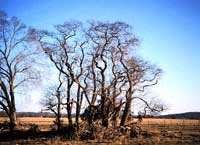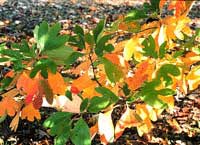Resource Library
Plant of the Week: Sassafras
The University of Arkansas System Division of Agriculture does not promote, support or recommend plants featured in "Plant of the Week." Please consult your local Extension office for plants suitable for your region.
Plant of the Week
Sassafras
Latin: Sassafras albidum

The search for a magic cure for what ails you is alive and well in America. This search is as old as mankind and seems to have been only slightly blunted by the rise of modern medicine and a better understanding of disease.
In the 16th century America became the new corner drug store for Europe. Tobacco and sassafras were the most important early medicinal plants. One went on to infamy and riches while the other ended up spawning a chain of drive-in restaurants.
Sassafras, Sassafras albidum, is a member of the laurel family and is native in much of the eastern woodlands, including all of Arkansas. In the northern part of its range it grows as small trees while in the South it may become 80 feet tall. However, we usually see it as a mid-size tree growing in thickets. The aromatic, slightly blue-green leaves are mitten shaped and can be up to six inches long, two-lobed or elliptical with no lobes. In the fall they change to shades of yellow, orange or red.
Yellow-green sassafras flowers appear in late April before the leaves appear. Plants are dioecious with individuals being either male or female. The plant is somewhat shy about fruiting, but when it does so the dark blue, pea-size berries are borne singly atop a bright red peduncle. From the profile, the fruit and peduncle looks like a miniature ice cream cone.
Sassafras is aromatic, giving off a fragrance somewhere between that of oranges and vanilla when crushed. The fragrance comes from safrole, which is at the highest concentration in the roots.

Until recent advances in medicine, healers always associated strong fragrances with curative powers. The aromatherapy movement uses the same principles practiced centuries ago by ancient
Egyptians and early American Indians. When European explorers first landed on the new continent, they were quick to adopt the native use of the plants they found.
About 1560 the French Huguenot settlement on the Saint Johns River in Florida first learned of sassafras from the tribes they encountered. When the Spanish captured the French settlement, they learned of sassafras from the few survivors. In 1571 the Spanish physician and botanist Nicolas Monardes published his book Joyfull Newes Out of the Newe Founde Worlde (from the English translation that appeared in 1577), and sassafras became the latest miracle cure.
The first shipment of sassafras went to England in 1602, and during much of the 17th century it was one of the principle New World exports. The Cherokees used the plant to cure everything from ague to venereal disease, including "overfatness." But by the 19th century Europeans had become disillusioned with the curative properties of sassafras, and it was largely abandoned. In 1963 scientists learned that a diet containing 1 percent of a rat’s weight in sassafras oil - an extremely high dose - caused cancer and the medical community officially blacklisted it.
But the southern rural culture continue to use sassafras as a flavoring. The oil is used in perfumery, root beer and candy such as licorice. In Cajan cooking any respectable file gumbo will have ground sassafras leaves for the flavoring and mucilaginous properties the ingredient imparts.
But the most common use is still sassafras tea, brewed from three-inch, kindling-size pieces of dried roots. The tea is prepared by steeping two or three of the sticks in a small quantity of water and then sweetening with sugar to taste. Perhaps the tea’s appeal and calming effect is more psychological than medicinal, but its popularity is not to be denied.
As a small landscape tree, sassafras is a welcome addition to any garden. It grows in full sun or light shade in most well drained sites. It is seldom found in nurseries because of the difficulty of transplanting. Bare root plants dug from the wild, even as small trees, almost always die. Container-grown trees offer the best likelihood of success but they are not commonly offered by nurserymen.
By: Gerald Klingaman, retired
Extension Horticulturist - Ornamentals
Extension News - September 28, 2001
The University of Arkansas System Division of Agriculture does not maintain lists of retail outlets where these plants can be purchased. Please check your local nursery or other retail outlets to ask about the availability of these plants for your growing area.